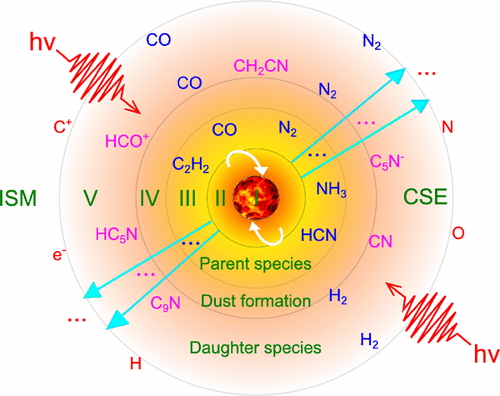当前位置:
X-MOL 学术
›
Chem. Rev.
›
论文详情
Our official English website, www.x-mol.net, welcomes your
feedback! (Note: you will need to create a separate account there.)
Negative Ions in Space
Chemical Reviews ( IF 51.4 ) Pub Date : 2017-01-23 00:00:00 , DOI: 10.1021/acs.chemrev.6b00480 Thomas J. Millar , Catherine Walsh 1, 2 , Thomas A. Field
Chemical Reviews ( IF 51.4 ) Pub Date : 2017-01-23 00:00:00 , DOI: 10.1021/acs.chemrev.6b00480 Thomas J. Millar , Catherine Walsh 1, 2 , Thomas A. Field
Affiliation

|
Until a decade ago, the only anion observed to play a prominent role in astrophysics was H–. The bound–free transitions in H– dominate the visible opacity in stars with photospheric temperatures less than 7000 K, including the Sun. The H– anion is also believed to have been critical to the formation of molecular hydrogen in the very early evolution of the Universe. Once H2 formed, about 500 000 years after the Big Bang, the expanding gas was able to lose internal gravitational energy and collapse to form stellar objects and “protogalaxies”, allowing the creation of heavier elements such as C, N, and O through nucleosynthesis. Although astronomers had considered some processes through which anions might form in interstellar clouds and circumstellar envelopes, including the important role that polycyclic aromatic hydrocarbons might play in this, it was the detection in 2006 of rotational line emission from C6H– that galvanized a systematic study of the abundance, distribution, and chemistry of anions in the interstellar medium. In 2007, the Cassini mission reported the unexpected detection of anions with mass-to-charge ratios of up to ∼10 000 in the upper atmosphere of Titan; this observation likewise instigated the study of fundamental chemical processes involving negative ions among planetary scientists. In this article, we review the observations of anions in interstellar clouds, circumstellar envelopes, Titan, and cometary comae. We then discuss a number of processes by which anions can be created and destroyed in these environments. The derivation of accurate rate coefficients for these processes is an essential input for the chemical kinetic modeling that is necessary to fully extract physics from the observational data. We discuss such models, along with their successes and failings, and finish with an outlook on the future.
中文翻译:

太空中的负离子
直到十年前,唯一的阴离子观察发挥天体物理学重要的角色入H - 。在H中的束缚-自由跃迁-主宰可见光不透明与光球温度星星低于7000 K,包括太阳。为H -阴离子也被认为已经在宇宙的非常早期演化形成分子氢的关键。一次H 2大爆炸发生大约50万年后,膨胀的气体便失去了内部引力能量并坍塌,形成了恒星物体和“原星系”,从而通过核合成产生了更重的元素,例如C,N和O。尽管天文学家曾考虑过一些可能在星际云和星际包络中形成阴离子的过程,包括多环芳烃可能在其中发挥的重要作用,但这是2006年检测到的C 6 H –这激发了对星际介质中阴离子的丰度,分布和化学性质的系统研究。2007年,卡西尼号飞行任务报告称,在土卫六的高层大气中意外发现了质荷比高达10000的阴离子。这一发现同样促使行星科学家对涉及负离子的基本化学过程进行了研究。在本文中,我们回顾了星际云,星际包膜,土卫六和彗星彗星中阴离子的观察结果。然后,我们讨论了在这些环境中可以创建和销毁阴离子的许多过程。这些过程的精确速率系数的推导是化学动力学建模的基本输入,而化学动力学建模是从观测数据中完全提取物理信息所必需的。我们讨论这样的模型,
更新日期:2017-01-23
中文翻译:

太空中的负离子
直到十年前,唯一的阴离子观察发挥天体物理学重要的角色入H - 。在H中的束缚-自由跃迁-主宰可见光不透明与光球温度星星低于7000 K,包括太阳。为H -阴离子也被认为已经在宇宙的非常早期演化形成分子氢的关键。一次H 2大爆炸发生大约50万年后,膨胀的气体便失去了内部引力能量并坍塌,形成了恒星物体和“原星系”,从而通过核合成产生了更重的元素,例如C,N和O。尽管天文学家曾考虑过一些可能在星际云和星际包络中形成阴离子的过程,包括多环芳烃可能在其中发挥的重要作用,但这是2006年检测到的C 6 H –这激发了对星际介质中阴离子的丰度,分布和化学性质的系统研究。2007年,卡西尼号飞行任务报告称,在土卫六的高层大气中意外发现了质荷比高达10000的阴离子。这一发现同样促使行星科学家对涉及负离子的基本化学过程进行了研究。在本文中,我们回顾了星际云,星际包膜,土卫六和彗星彗星中阴离子的观察结果。然后,我们讨论了在这些环境中可以创建和销毁阴离子的许多过程。这些过程的精确速率系数的推导是化学动力学建模的基本输入,而化学动力学建模是从观测数据中完全提取物理信息所必需的。我们讨论这样的模型,











































 京公网安备 11010802027423号
京公网安备 11010802027423号